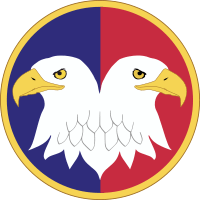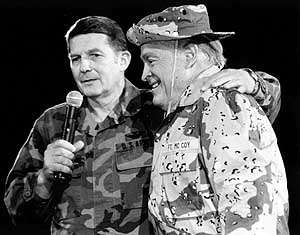Fort McCoy, Wisconsin
Fort McCoy | |
|---|---|
| Part of United States Army Reserve Command (USARC) | |
| Located near: Tomah, Wisconsin | |
|
Sign outside the main gate | |
| Coordinates | 44°00′35″N 90°41′00″W / 44.00972°N 90.68333°WCoordinates: 44°00′35″N 90°41′00″W / 44.00972°N 90.68333°W |
| Site information | |
| Owner | United States Army |
| Condition | Active |
| Site history | |
| Built | 1909 |
| Built by | Major General Robert Bruce McCoy |
| Garrison information | |
| Occupants | United States Army, 86th Training Division, Regional Support Command, 181st Infantry Brigade, 426th Regiment (Regional Training Institute) & Wisconsin Military Academy, Wisconsin State Patrol, Naval Mobile Construction Battalion-25, Equipment Concentration Site 67, Maneuver Area Training Equipment Site, NCO Academy |
| Fort McCoy, Wisconsin | ||
|---|---|---|
| ||
 | ||
| Coordinates: 44°00′13″N 90°24′36″W / 44.0035°N 90.41°W | ||
| Country | United States | |
| State | Wisconsin | |
| County | Monroe County | |
| Area | ||
| • Total | 90 sq mi (240 km2) | |
| Elevation | 873 ft (266 m) | |
| Population (2010 Census) | ||
| • Total | 2,215 | |
| • Density | 24/sq mi (9.2/km2) | |
| Time zone | Central (CST) (UTC-5) | |
| • Summer (DST) | Central (CDT) (UTC-4) | |
| ZIP code | 54656 | |
| Area code(s) | 608 | |

Fort McCoy is a United States Army installation. It is located on 60,000 acres (240 km2) between Sparta and Tomah, Wisconsin, in Monroe County. Since its creation in 1909, the post has been used primarily as a military training center. A part of Fort McCoy is also used by the Wisconsin State Patrol as a training facility.[1]
History
The post has been in virtually constant use since it was first formed as the "Sparta Maneuver Tract" on 14,000 acres (57 km2) in 1909. At first, the tract was made up of two camps, Camp Emory Upton and Camp Robinson. These were separated by a line of the Chicago, Milwaukee, St. Paul and Pacific Railroad that ran across the land from east to west. In 1910, the army renamed the entire tract "Camp Bruce E. McCoy" for Robert Bruce McCoy, a retired major general who first proposed the area as a training ground and bought part of the property on which the fort stands. In 1926, the name of the post was shortened to "Camp McCoy".
In 1938, the United States began a major expansion of the camp. This included the addition of over 45,000 acres (180 km2) to the post, as well as the construction of several new structures including living quarters for the troops. This increased the camp's capacity to 35,000 soldiers. In all, the project was estimated to have cost about $30 million. The expansion was officially concluded with a new inauguration on August 30, 1942.
During World War II, Fort McCoy was used as a detention center for approximately 170 Japanese and 120 German and Italian American civilians arrested as potentially dangerous "enemy aliens" (despite a lack of evidence to demonstrate their supposed risk) in 1942.[2] After the internees were transferred to other camps, McCoy was used as a training facility for units from across the country preparing to enter combat, including the segregated all-Nisei 100th Infantry Battalion.[3] The post was also used as a prisoner-of-war (POW) camp during the conflict, holding 4,000 Japanese and German POWs.[2] Fort McCoy's POWs were featured in the 2011 film "Fort McCoy."
The camp was briefly deactivated following World War II, but with the advent of the Korean War in 1950, it was once again used for training. This continued until 1953, when the camp was again deactivated. It was then used to house various small national, state and civilian projects, and served as a training center for the National Guard and the Job Corps.
In the 1970s, a variety of ideas were offered to make use of the camp's land including a suggestion by researchers to balance Wisconsin's population distribution by creating a major city on the 60,000 acre (240 km2) post that would rival Milwaukee. In response, a Milwaukee official proposed that the camp be used as a landfill for Milwaukee garbage.[4] In 1973, the Army reactivated Camp McCoy as a permanent training center, and on September 30, 1974, it was officially re-designated as Fort McCoy.
In the 1990s, a second major construction project was undertaken, costing around $140 Million. Today, Fort McCoy serves as a Total Force Training Center. Around 100,000 members of the military are trained at the fort every year,[5] and the total number has exceeded 149,000 in the past.[6]
Fort McCoy also is the headquarters of Naval Mobile Construction Battalion-25 (Spades and Clubs) which served a distinguished tour in Iraq and SOUTHCOM (including Cuba, Jamaica, Dominican Republic, and earthquake disaster relief to Haiti).
The 181st Infantry Brigade is the largest unit stationed at Fort McCoy. The brigade is responsible for training selected United States Army Reserve and Army National Guard units in the Central-Northern United States to support contingency operations in the Global War on Terror.
Deployments

Fort McCoy was used as a mobilization station during Operation Desert Shield and Operation Desert Storm. This was the first time units had mobilized at Fort McCoy since the Korean War. 74 military units deployed through Fort McCoy, totaling over 9,000 Soldiers, 8% of the reserve forces activated during the Persian Gulf War.[7] Volk Field Air National Guard Base was used as the primary point of departure. In addition, over 3,000 pieces of equipment were deployed from Fort McCoy by train.
The 769th Engineer Battalion and the 927th Sapper Company of the 225th Engineer Brigade of the Louisiana Army National Guard mobilized for deployments to both Iraq and Afghanistan in 2008 and 2009. The 890th Engineer Battalion of the Mississippi Army National Guard conducted Mobilization training at McCoy from April to June 2008 before deploying to Iraq. 194th Engineer Brigade mobilized from Fort McCoy to Iraq in 2009 and 190th Engineer Company mobilized to Afghanistan from there in 2010, both are part of the Tennessee Army National Guard.
During February and March 2003,the Wisconsin Army National Guard's 229th Combat Support Equipment (CSE) Engineer Company deployed from Fort McCoy,in support of Operation Iraqi Freedom.
From December through February 2003-04, the 458th Combat Engineers of Johnstown, Pennsylvania mobilized through Fort McCoy. One of the soldiers mobilized was an intra-Reserve transfer or "fill" from Boise, Idaho, who later used his experiences there to form a major chapter in the online webcomic "BOHICA Blues." The entirety of Chapter 3, "Mobe Station", takes place at Ft. McCoy and the surrounding area of Sparta and Tomah.[8]
References
- ↑ [Wisconsin State Patrol Facilities
- 1 2 "Camp McCoy" Densho Encyclopedia (accessed 11 June 2014)
- ↑ J. Burton, M. Farrell, F. Lord, R. Lord. Confinement and Ethnicity: An Overview of World War II Japanese American Relocation Sites, "Department of Justice and U.S. Army Facilities", Ch. 17 (National Park Service)
- ↑ Burt, Terry. "Fort McCoy timeline." La Crosse Tribune 8 May 2005.
- ↑ Fort McCoy Facts & Figures 2005
- ↑ history
- 1 2 "McCoy rallied to support nation's call". The Triad. Fort McCoy.
- ↑ BOHICA Blues

